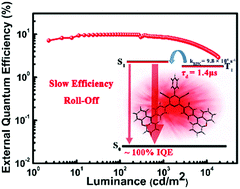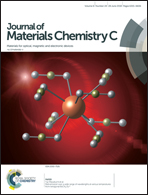Emitters with a pyridine-3,5-dicarbonitrile core and short delayed fluorescence lifetimes of about 1.5 μs: orange-red TADF-based OLEDs with very slow efficiency roll-offs at high luminance†
Abstract
The efficiency roll-off with increasing brightness in thermally activated delayed fluorescence (TADF)-based OLEDs greatly impedes their future applications. The combination of varying numbers of phenoxazine (PXZ) donors with pyridine-3,5-dicarbonitrile (PCN) acceptors has afforded three orange-red TADF emitters PXZ-PCN, bis-PXZ-PCN and tri-PXZ-PCN. The singlet–triplet energy gap (ΔEST) of the molecules is in good agreement with that predicted by corrected time-dependent density functional theory. When bis-PXZ-PCN is doped into the host material CBP (10 wt%), the ΔEST value of 0.04 eV is achieved, and this facilitates effective reverse intersystem crossing (RISC, kRISC = 9.8 × 105 s−1). Bis-PXZ-PCN endows its device with orange-red electroluminescence peak at 600 nm, accompanied by maximum external quantum efficiency of 9.8% and an impressive slow efficiency roll-off of 15% at a high luminance of 1000 cd m−2, which is among the lowest roll-off value of the reported orange-red to red TADF-based OLEDs.



 Please wait while we load your content...
Please wait while we load your content...